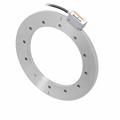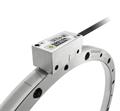High performance rotary (angle) encoders for machine tools
December 2014
 RESOLUTE™ adds the benefits of being a true absolute encoder. This means it acquires absolute position immediately upon switch-on, so the machine knows the exact orientation of the axis and motor commutation angle without the need for a reference (datum) return. This is particularly useful in the case of direct-drive rotary (torque) motors and upgrading to direct encoder feedback on gear-driven rotary axes.
RESOLUTE™ adds the benefits of being a true absolute encoder. This means it acquires absolute position immediately upon switch-on, so the machine knows the exact orientation of the axis and motor commutation angle without the need for a reference (datum) return. This is particularly useful in the case of direct-drive rotary (torque) motors and upgrading to direct encoder feedback on gear-driven rotary axes.
What can RESOLUTE™, SiGNUM™ and TONiC™ do for you?
 RESOLUTE, SiGNUM and TONiC rotary encoders help the world's leading machine tool manufacturers achieve optimum performance:
RESOLUTE, SiGNUM and TONiC rotary encoders help the world's leading machine tool manufacturers achieve optimum performance:
- Improve surface finish performance
- Increase accuracy
- Increase work output
- Reduce heat build-up
- Increase servo loop gains on direct-drive axes
- Simplify axis design
- Reduce cost of ownership
RESOLUTE, SiGNUM and TONiC encoders achieve these performance benefits because they have two major advantages over traditional enclosed encoders.
First, because they are non-contact, they eliminate backlash, shaft wind-up and other mechanical hysteresis errors that plague traditional enclosed encoders.

Second, SiGNUM and TONiC apply dynamic signal conditioning including Auto Gain Control, Auto offset Control and Auto Balance Control to ensure exceptional signal purity. Therefore, Sub-Divisional Error (SDE) is controlled to ±30 nm (±0.06 arc seconds on 206 mm Ø RESM). RESOLUTE incorporates advanced optics that inherently control SDE to ±40 nm (±0.08 arc seconds on 209 mm Ø RESA).
The result? Significantly improved velocity ripple for better contouring performance.
Furthermore, for high-resolution axes demanding the ultimate precision control, Renishaw offers low noise variants of SiGNUM and TONiC encoders with reduced jitter, improving positional stability. RESOLUTE has inherent low noise (jitter) of <10 nm RMS.
Both the RESOLUTE absolute encoder and SiGNUM incremental encoder offer a variety of high-accuracy scale options that offer simple integration and quick, easy installation combined with linear encoder accuracies to ±1 µm and angle encoder accuracies to ±1 arc second.